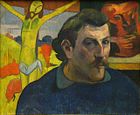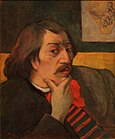Paul Gauguin
- Birth Date:
- 07.06.1848
- Death date:
- 08.05.1903
- Person's maiden name:
- Eugène Henri Paul Gauguin
- Extra names:
- Pols Gogēns, Эжен Анри Поль Гоген, Eižēns Henrijs Pols Gogēns, Eugène Henri Paul Gauguin, Ežēns Anrī Pols Gogēns
- Categories:
- Artist, Painter
- Nationality:
- french
- Cemetery:
- Atuona, Calvary Cemetery
Eugène Henri Paul Gauguin (French: [øʒɛn ɑ̃ʁi pol ɡoɡɛ̃]; 7 June 1848 – 8 May 1903) was a leading French Post-Impressionist artist who was not well appreciated until after his death. Gauguin was later recognized for his experimental use of colors and synthetist style that were distinguishably different from Impressionism. His work was influential to the French avant-garde and many modern artists, such as Pablo Picasso and Henri Matisse. Gauguin’s art became popular after his death and many of his paintings were in the possession of Russian collector Sergei Shchukin. He was an important figure in the Symbolist movement as a painter, sculptor, print-maker, ceramist, and writer. His bold experimentation with coloring led directly to the Synthetist style of modern art, while his expression of the inherent meaning of the subjects in his paintings, under the influence of the cloisonnist style, paved the way to Primitivism and the return to the pastoral. He was also an influential proponent of wood engraving and woodcuts as art forms.
Biography
Gauguin was born in Paris, France, to journalist Clovis Gauguin and Alina Maria Chazal, daughter of the proto-socialist leader Flora Tristan, a feminist precursor whose father was part of an influential Peruvian family. In 1850 the family left Paris for that country, motivated by the political climate of the period. Clovis died on the voyage, leaving eighteen-month-old Paul, his mother, and sister, to fend for themselves. They lived for four years in Lima with Paul's uncle and his family. The imagery of Peru would later influence Gauguin in his art. It was in Lima that Gauguin encountered his first art. His mother admired Pre-Columbian pottery, collecting Inca pots that some colonists dismissed as barbaric. "One of Gauguin's few early memories of his mother was of her wearing the traditional costume of Lima, one eye peeping from behind her manteau, the mysterious one-eye veil that all women in Lima went out in. [...] He was always drawn to women with a 'traditional' look. This must have been the first of the colourful female costumes that were to haunt his imagination."
At the age of seven, Gauguin and his family returned to France, moving to Orléans to live with his grandfather. The Gauguins came originally from the area and were market gardeners and greengrocers: gauguin means 'walnut-grower'. His father had broken with family tradition to become a journalist in Paris. Gauguin soon learned French, though his first and preferred language remained Peruvian Spanish, and he excelled in his studies. After attending a couple of local schools he was sent to a Catholic boarding school in La Chapelle-Saint-Mesmin, which he hated. He spent three years at the school. At seventeen, Gauguin signed on as a pilot's assistant in the merchant marine to fulfill his required military service. Three years later, he joined the French navy in which he served for two years. He was somewhere in the Caribbean when he found out that his mother had died. In 1871, Gauguin returned to Paris where he secured a job as a stockbroker. His mother's very rich boyfriend, Gustave Arosa, got him a job at the Paris Bourse; Gauguin was twenty-three. He became a successful Parisian businessman and remained one for eleven years.
In 1873, he married a Danish woman, Mette-Sophie Gad (1850–1920). Over the next ten years, they had five children: Émile (1874–1955); Aline (1877–1897); Clovis (1879–1900); Jean René (1881–1961); and Paul Rollon (1883–1961). By 1884, Gauguin had moved with his family to Copenhagen, Denmark, where he pursued a business career as a tarpaulin salesman. It was not a success: He could not speak Danish, and the Danes did not want French tarpaulins. Mette became the chief breadwinner, giving French lessons to trainee diplomats. His middle-class family and marriage fell apart after 11 years when Gauguin was driven to paint full-time. He returned to Paris in 1885, after his wife and her family asked him to leave because he had renounced the values they shared. Paul Gauguin's last physical contact with them was in 1891. Like his friend Vincent van Gogh, with whom in 1888 he spent nine weeks painting in Arles, Paul Gauguin experienced many bouts of depression and at one time attempted suicide. He traveled to Martinique in search of an idyllic landscape and worked as a laborer on the Panama Canal construction; he was dismissed from his job after only two weeks.

I Raro te Oviri, 1891, Dallas Museum of Art
In 1891, Gauguin sailed to French Polynesia to escape European civilization and "everything that is artificial and conventional". He wrote a book titled Noa Noa describing his experiences in Tahiti. There have been allegations by modern critics that the contents of the book were fantasized and plagiarized.
Gauguin left France again on 3 July 1895, never to return. His time away, particularly in Tahiti and Hiva Oa Island, was the subject of much interest both then and in modern times due to his alleged sexual exploits. He was known to have had trysts with several prepubescent native girls, some of whom appear as subjects of his paintings.
Gauguin outlived two of his children; his favorite daughter Aline died of pneumonia and his son Clovis died of a blood infection following a hip operation. Emile Gauguin worked as a construction engineer in the U.S. and is buried in Lemon Bay Historical Cemetery, in Florida. Jean René became a well-known sculptor and a staunch socialist. He died on 21 April 1961 in Copenhagen. Pola (Paul Rollon) became an artist and art critic and wrote a memoir, My Father, Paul Gauguin (1937). Gauguin had several children by his mistresses: Germaine (born 1891) with Juliette Huais (1866–1955); Emile Marae a Tai (born 1899) with Pau'ura; and a daughter (born 1902) with Mari-Rose. There is some speculation that the Belgian artist Germaine Chardon was Gauguin's daughter. Emile Marae a Tai, illiterate and raised in Tahiti, was brought to Chicago by French journalist Josette Giraud in 1963 and became an artist of note.
In French Polynesia, toward the end of his life, sick and suffering from an unhealed injury, he got into legal trouble for taking the natives' side against French colonialists. On 27 March 1903, while living in the Marquesas Islands, he was charged with libeling the governor, M Guicheray, and given three days to prepare his defense. He was fined 500 francs and sentenced to three months in prison. On 2 April, he appealed for a new trial in Papeete. At the second trial, Gauguin was fined 500 francs and sentenced to one month in prison. At that time he was being supported by the art dealer Ambroise Vollard. Suffering from syphilis, he died at 11 a.m. on 8 May 1903 of an overdose of morphine and possibly heart attack before he could start the prison sentence. His body had been weakened by alcohol. He was 54 years old.
Gauguin was buried in Calvary Cemetery (Cimetière Calvaire), Atuona, Hiva ‘Oa at 2 p.m. the next day.
Artistic career
In 1873, around the same time as he became a stockbroker, Gauguin began painting in his free time. His Parisian life centred on the 9th arrondissement. Gauguin lived at 21 rue la Bruyère. All around were the cafés frequented by the Impressionists. Gauguin also visited galleries frequently and purchased work by emerging artists. He formed a friendship with Pissarro and visited him on Sundays, to paint in his garden, and Pissarro introduced him to various other artists. In 1877 Gauguin "moved downmarket and across the river to the poorer, newer, urban sprawls" of Vaugirard. Here, on the third floor at 8 rue Carcel, he had the first home in which he had a studio. He showed paintings in Impressionist exhibitions held in 1881 and 1882 - (earlier a sculpture, of his son Emile, had been the only sculpture in the 4th Impressionist Exhibition of 1879.) Over two summer holidays, he painted with Pissarro and occasionally Paul Cézanne.
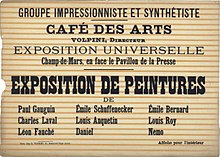
Poster of the 1889 Exhibition of Paintings by the Impressionist and Synthetist Group, at Café des Arts, known as the The Volpini Exhibition, 1889.

Where Do We Come From? What Are We? Where Are We Going?, 1897, Boston Museum of Fine Arts, Boston, MA, USA
In 1887, after visiting Panama, Gauguin spent several months near Saint Pierre in Martinique, in the company of his friend the artist Charles Laval. At first, the 'negro hut' in which they lived suited him, and he enjoyed watching people in their daily activities.[13] However, the weather in the summer was hot and the hut leaked in the rain. He also suffered dysentery and marsh fever. While in Martinique, he produced between ten and twenty works (twelve being the most common estimate) and traveled widely and apparently came into contact with a small community of Indian immigrants, a contact that would later influence his art through the incorporation of Indian symbols. Gauguin, along with Émile Bernard, Charles Laval, Émile Schuffenecker and many others, frequently visited the artist colony of Pont-Aven in Brittany. By the bold use of pure color and Symbolist choice of subject matter, the group is now considered a Pont-Aven School. Disappointed with Impressionism, Gauguin felt that traditional European painting had become too imitative and lacked symbolic depth. By contrast, the art of Africa and Asia seemed to him full of mystic symbolism and vigour. There was a vogue in Europe at the time for the art of other cultures, especially that of Japan (Japonism). He was invited to participate in the 1889 exhibition organized by Les XX.
Cloisonnism and Synthetism

The Yellow Christ (Le Christ jaune), 1889, Albright-Knox Art Gallery, Buffalo, NY
Under the influence of folk art and Japanese prints, Gauguin's work evolved towards Cloisonnism, a style given its name by the critic Édouard Dujardin in response to Émile Bernard's method of painting with flat areas of color and bold outlines, which reminded Dujardin of the Medieval cloisonné enamelling technique. Gauguin was very appreciative of Bernard's art and of his daring with the employment of a style which suited Gauguin in his quest to express the essence of the objects in his art.
In The Yellow Christ (1889), often cited as a quintessential Cloisonnist work, the image was reduced to areas of pure color separated by heavy black outlines. In such works Gauguin paid little attention to classical perspective and boldly eliminated subtle gradations of color, thereby dispensing with the two most characteristic principles of post-Renaissance painting. His painting later evolved towards Synthetism in which neither form nor color predominate but each has an equal role.

Paul Gauguin, Te aa no areois (The Seed of the Areoi), 1892, The Museum of Modern Art
Living in Mataiea Village in Tahiti, he painted Fatata te Miti ("By the Sea"), "Ia Orana Maria" ("Ave Maria"), and other depictions of Tahitian life. In 1893 Gauguin returned to France, where he painted Mahana No Atua ("Day of the God"; 1894) which depicted Tahitian religion, even though the idol in the center, Hina, is derived more from Indian and Southeast Asian archetypes. Huts, mountains, dancers, a flute player, and other reminiscences of Polynesian life form the setting for the foreground subject of three women at the edge of a pool. Its illogical colors make the pool seem abstract, its apparent depth evoking a sort of symbolism: The woman whose toes touch the water on the left side of the pool represents birth; the figure in the middle, who is sitting upright with both feet in the water, represents life; while the figure on the right represents death by turning away from the pool. He moved to Punaauia in 1897, where he created the masterpiece painting "Where Do We Come From? What Are We? Where Are We Going?" and then lived the rest of his life in the Marquesas Islands, returning to France only once, when he painted at Pont-Aven.
His works of that period are full of quasi-religious symbolism and an exoticized view of the inhabitants of Polynesia. In Polynesia, he sided with the native peoples, clashing often with the colonial authorities and with the Catholic Church. During this period he also wrote the book Avant et après (before and after), a fragmented collection of observations about life in Polynesia, memories from his life and comments on literature and paintings.
Historical significance
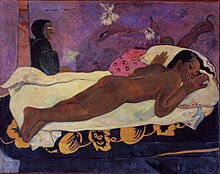
Spirit of the Dead Watching 1892, Albright-Knox Art Gallery, Buffalo, NY
Primitivism was an art movement of late 19th century painting and sculpture; characterized by exaggerated body proportions, animal totems, geometric designs and stark contrasts. The first artist to systematically use these effects and achieve broad public success was Paul Gauguin. The European cultural elite discovering the art of Africa, Micronesia, and Native Americans for the first time were fascinated, intrigued and educated by the newness, wildness and the stark power embodied in the art of those faraway places. Like Pablo Picasso in the early days of the 20th century, Gauguin was inspired and motivated by the raw power and simplicity of the so-called Primitive art of those foreign cultures.
Gauguin is also considered a Post-Impressionist painter. His bold, colorful and design oriented paintings significantly influenced Modern art. Artists and movements in the early 20th century inspired by him include Vincent van Gogh, Henri Matisse, Pablo Picasso, Georges Braque, André Derain, Fauvism, Cubism and Orphism, among others. Later he influenced Arthur Frank Mathews and the American Arts and Crafts Movement.
John Rewald, an art historian focused on the birth of Modern art, wrote a series of books about the Post-Impressionist period, including Post-Impressionism: From Van Gogh to Gauguin (1956) and an essay, Paul Gauguin: Letters to Ambroise Vollard and André Fontainas (included in Rewald's Studies in Post-Impressionism, 1986), discusses Gauguin's years in Tahiti, and the struggles of his survival as seen through correspondence with the art dealer Vollard and others.
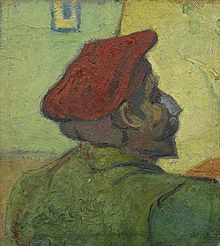
Vincent van Gogh, Paul Gauguin (Man in a Red Beret), 1888, Van Gogh Museum, Amsterdam (F546)
Gauguin and Van Gogh
Gauguin's relationship with Van Gogh was rocky. Gauguin had shown an early interest in Impressionism, and the two shared bouts of depression and suicidal tendencies. In 1888, Gauguin and Van Gogh spent nine weeks together, painting in the latter's Yellow House in Arles. During this time, Gauguin became increasingly disillusioned with Impressionism, and the two quarreled. On the evening of December 23, 1888, frustrated and ill, Van Gogh confronted Gauguin with a razor blade. In a panic, Van Gogh fled to a local brothel. While there, he cut off the lower part of his left ear lobe. He wrapped the severed tissue in newspaper and handed it to a prostitute named Rachel, asking her to "keep this object carefully." Gauguin left Arles, and a few days later Van Gogh was hospitalized. They never saw each other again, but they continued to correspond and in 1890 Gauguin proposed they form an artist studio in Antwerp. In an 1889 sculptural self-portrait Jug in the form of a Head, Self-portrait Gauguin portrays the traumatic relationship with Van Gogh.
Legacy
The vogue for Gauguin's work started soon after his death. Many of his later paintings were acquired by the Russian collector Sergei Shchukin. A substantial part of his collection is displayed in the Pushkin Museum and the Hermitage. Gauguin paintings are rarely offered for sale; their price may be as high as $39.2 million US$.
Gauguin's posthumous retrospective exhibitions at the Salon d'Automne in Paris in 1903 and an even larger one in 1906 had a stunning and powerful influence on the French avant-garde and in particular Pablo Picasso's paintings. In the autumn of 1906, Picasso made paintings of oversized nude women, and monumental sculptural figures that recalled the work of Paul Gauguin and showed his interest in primitive art. Picasso's paintings of massive figures from 1906 were directly influenced by Gauguin's sculpture, painting and his writing as well. The power evoked by Gauguin's work led directly to Les Demoiselles d'Avignon in 1907.
According to Gauguin biographer David Sweetman, Picasso as early as 1902 became a fan of Gauguin's work when he met and befriended the expatriate Spanish sculptor and ceramist Paco Durrio (1875–1940), in Paris. Durrio had several of Gauguin's works on hand because he was a friend of Gauguin's and an unpaid agent of his work. Durrio tried to help his poverty-stricken friend in Tahiti by promoting his oeuvre in Paris. After they met, Durrio introduced Picasso to Gauguin's stoneware, helped Picasso make some ceramic pieces and gave Picasso a first La Plume edition of Noa Noa: The Tahiti Journal of Paul Gauguin. In addition to seeing Gauguin's work at Durrio's Picasso also saw the work at Ambroise Vollard's gallery where both he and Gauguin were represented.

Paul Gauguin, 1894, Oviri (Sauvage), partially glazed stoneware, 75 x 19 x 27 cm, Musée d'Orsay, Paris
Concerning Gauguin's impact on Picasso John Richardson wrote,
The 1906 exhibition of Gauguin's work left Picasso more than ever in this artist's thrall. Gauguin demonstrated the most disparate types of art—not to speak of elements from metaphysics, ethnology, symbolism, the Bible, classical myths, and much else besides—could be combined into a synthesis that was of its time yet timeless. An artist could also confound conventional notions of beauty, he demonstrated, by harnessing his demons to the dark gods (not necessarily Tahitian ones) and tapping a new source of divine energy. If in later years Picasso played down his debt to Gauguin, there is no doubt that between 1905 and 1907 he felt a very close kinship with this other Paul, who prided himself on Spanish genes inherited from his Peruvian grandmother. Had not Picasso signed himself 'Paul' in Gauguin's honor.

Gaugin's grave in Atuona.
Both David Sweetman and John Richardson point to the Gauguin sculpture called Oviri (literally meaning 'savage'), the gruesome phallic figure of the Tahitian goddess of life and death that was intended for Gauguin's grave, exhibited in the 1906 retrospective exhibition that even more directly led to Les Demoiselles. Sweetman writes, "Gauguin's statue Oviri, which was prominently displayed in 1906, was to stimulate Picasso's interest in both sculpture and ceramics, while the woodcuts would reinforce his interest in print-making, though it was the element of the primitive in all of them which most conditioned the direction that Picasso's art would take. This interest would culminate in the seminal Les Demoiselles d'Avignon."
According to Richardson,
Picasso's interest in stoneware was further stimulated by the examples he saw at the 1906 Gauguin retrospective at the Salon d'Automne. The most disturbing of those ceramics (one that Picasso might have already seen at Vollard's) was the gruesome Oviri. Until 1987, when the Musée d'Orsay acquired this little-known work (exhibited only once since 1906) it had never been recognized as the masterpiece it is, let alone recognized for its relevance to the works leading up to the Demoiselles. Although just under 30 inches high , Oviri has an awesome presence, as befits a monument intended for Gauguin's grave. Picasso was very struck by Oviri. 50 years later he was delighted when [Douglas] Cooper and I told him that we had come upon this sculpture in a collection that also included the original plaster of his cubist head. Has it been a revelation, like Iberian sculpture? Picasso's shrug was grudgingly affirmative. He was always loath to admit Gauguin's role in setting him on the road to primitivism.
Critic Joel Silverstein in Reviewny.com suggested Gauguin's style influenced painters such as Julian Hatton, Joan Miró and Ludwig von Hofmann.
Gauguin's life inspired W. Somerset Maugham's novel The Moon and Sixpence. Mario Vargas Llosa based his 2003 novel The Way to Paradise on Gauguin's life, and that of his grandmother Flora Tristan.
Gauguin is also the subject of at least two operas: Federico Elizalde's Paul Gauguin (1943); and Gauguin (a synthetic life) by Michael Smetanin and Alison Croggon. Déodat de Séverac wrote his Elegy for piano in memory of Gauguin.
The Danish produced film "Oviri" (1986) is a biographical film. It follows the painter from the time he returns to Paris in 1893 after a long stay in Tahiti and must confront his wife, his children, and his former lover. It ends when he returns to Tahiti two years later.
The Japanese styled Gauguin Museum, opposite the Botanical Gardens of Papeari in Papeari, Tahiti, contains some exhibits, documents, photographs, reproductions and original sketches and block prints of Gauguin and Tahitians. In 2003, the Paul Gauguin Cultural Center opened in Atuona in the Marquesas Islands.
List of paintings
Gallery
-

Portrait of Madame Gauguin, c. (1880–1881)
-
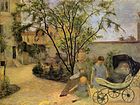
Garden in Vaugirard, or the Painter's Family in the Garden in Rue Carcel, (1881)
-

Still-Life with Fruit and Lemons, c. (1880)
-
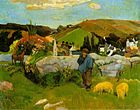
The Swineherd, Brittany, (1888)
-

Les Alyscamps, (1888)
-

Vision After the Sermon (Jacob wrestling with the angel), (1888)
-
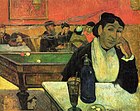
Night Café at Arles, (Mme Ginoux), (1888)
-

Still-Life with Japanese Woodcut, (1889)
-
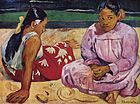
Tahitian Women on the Beach, (1891)
-

Woman with a Flower, (1891)
-

The Moon and the Earth (Hina tefatou), (1893)
-

Annah, the Javanese, (1893)
-
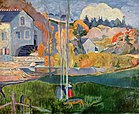
Watermill in Pont-Aven, (1894)
-

The Midday Nap, (1894)
-

Maternity, (1899)
-

Two Tahitian Women, (1899)
-

Cruel Tales (Exotic Saying), (1902)
-
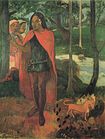
The Sorcerer of Hiva Oa , (1902)
-
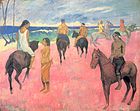
Riders on the Beach, (1902)
-
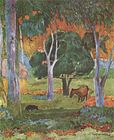
Landscape on La Dominique (Hiva OAU), (1903)
Self-portraits
-

Self-portrait, 1875–1877, Fogg Museum, Cambridge, Massachusetts
-

Self-portrait, 1885, Kimbell Art Museum, Fort Worth, Texas
-
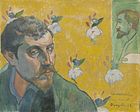
Self-portrait, 1888, Van Gogh Museum, Amsterdam
-

Self-portrait, 1889, National Gallery of Art, Washington, DC
-

Christ in the Garden of Olives, 1889, (Gauguin's self-portrait), Norton Museum of Art
-

Jug in the Form of a Head, Self-portrait, 1889, Kunstindustrimuseet, Copenhagen
-
Self-portrait, 1889–1890, Musée d'Orsay, Paris, France
-

Self-portrait, 1893, Musée d'Orsay
-
Self-Portrait, c. 1893, The Detroit Institute of Arts
-
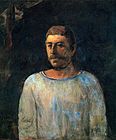
Self-portrait, 1896, São Paulo Museum of Art
-
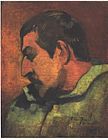
Self-Portrait (for my friend Daniel), 1896, Musée d'Orsay
-

Self Portrait, 1902, Kunstmuseum Basel
Source: wikipedia.org
No places

| Relation name | Relation type | Description | ||
|---|---|---|---|---|
| 1 |  | Vincent van Gogh | Familiar | |
| 2 |  | Henri de Toulouse-Lautrec | Idea mate |
No events set



